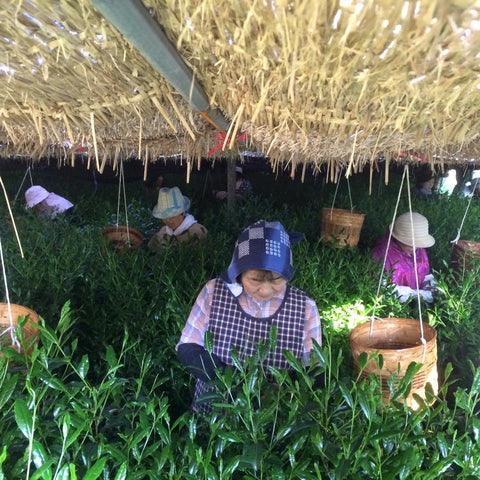これは抹茶の生産に関する簡単な入門書です。私たちは茶農家と茶工場の両方と関わっているからこそ、これらすべてを学んだのです。小規模な家族経営の茶農家/茶工場で作られた抹茶は、 http://www.yunomi.life/collections/matchaでご覧いただけます。
抹茶の製造工程
- 茶畑には風味を良くするために肥料を与えます。施肥量が多いほど風味が強くなります。これが、オーガニック抹茶が同じ価格帯で劣ると言われる理由の一つです。もちろん、風味の好みは人それぞれですので、私たちは無肥料(無農薬)の農家さんにも協力を仰いでいます。
- 茶の木は新芽が出た後、4~5週間日陰にされます。一般的に春に行われるのは、春の茶葉が最も風味が強いためですが、夏や秋の茶葉からも質の低い抹茶が生まれます。年が進むにつれて、茶葉の風味と色は次第に薄れていきます。

機械収穫の場合は、生垣に直接プラスチック製のカバーを被せます。手摘みの場合は(生産される抹茶のごく一部のみが手摘みされます)、樹冠で日よけをします。最高品質の抹茶は、手間のかかる伝統的な資材(藁、竹の足場など)を使用します。
遮光することで葉に含まれる抗酸化物質が減少し、苦味が軽減されます。一方で、テアニンも保持され、うま味と風味が生まれます。
- 機械または手摘みで摘まれた茶葉は、すぐに工場に運ばれ、蒸し、専用の炉で乾燥させます。揉み工程がないため、他の種類の緑茶とは異なります。こうしてできた茶葉は、まだ粗い状態ですが「碾茶」と呼ばれます。

実は、煎茶用の揉捻機を用いて特殊な技術で抹茶を作ることも可能です。その場合、碾茶ではなく「もが茶」と呼ばれることになり、出来上がった粉末は抹茶と呼ぶ人もいれば、模造品と呼ぶ人もいます。
葉を後日加工するために保存するには、蒸した後、乾燥する前に急速冷凍することができます。
- 碾茶は精製されます。つまり、茶葉を細かく刻んで茎や葉脈、塵を取り除き、より簡単に挽けるように細かいフレーク状にします。
最高品質の抹茶は、苦味をさらに引き出すために、さらに半年間冷蔵保存した碾茶葉から作られます。現代の冷蔵保存(-20℃!)された碾茶葉は、何年も保存可能です!
- 碾茶は抹茶に挽かれます。これは石臼(より高価な抹茶)やその他の粉砕機で行われますが、中には高度な技術が開発され、非常に高品質な抹茶を生産できるものもあります。
この時点で、粉末としての抹茶の風味、色、香りは通常のお茶よりもはるかに早く劣化するため、光や空気中の湿度への露出を最小限に抑える必要があります。



